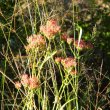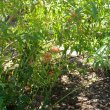| Botanical Name |
|
| Family |
Crassulaceae - The crassula family. |
| Pronunciation |
kal-un-KOH-ee ro-tun-dih-FOH-lee-uh |
| Common Name(s) |
English: Common kalanchoe
IsiXhosa: umfayisele yasehlatini; ipewula
IsiZulu: Idambisa; Uchane; Umadinsane
|
| Plant Group |
- Succulent A plant having fleshy stems or leaves often adapted to dry conditions.
|
| Plant Size |
- Small to Medium
| Tree | 8m to 15m |
| Shrub | 75cm to 1m |
| Perennial/ground cover | 20cm to 40cm |
| Bulb | 30cm to 40cm |
| Succulent | 20cm to 40cm |
|
| Position |
- Canopy Shade Canopy shade is found below closely grown trees where some light filters through. Ideal for the protection of herbaceous plants.
- Dry Shade Shady areas where soil has poor water retention or are dependent on rain for their moisture needs.
- Light or Dappled Shade Found below trees with sparse, open foliage. Ideal for the protection of herbaceous plants.
- Partial Shade The area is in shade for part of the day and in full sun for part of the day.
|
| General Information |
- Drought Tolerance: High The plant is well adapted to arid conditions; it can survive long periods of drought and high temperatures without extra water.
- Evergreen Plants that have leaves all year round.
- Frost: Hardy The plant can withstand freezing temperatures or frost without artificial protection.
- Water Wise Plant species originating from low rainfall regions that require less water to survive and thrive than other plant species.
|
| Specific Information |
Kalanchoe rotundifolia is a very common succulent with blue-green leaves, round to oval in shape with the bigger leaves clustered at the base of the stem. The stem is rather brittle and the leaves fall off very easily but as these often form new plants, it should not be a concern.
|
| Ad Break |
|
| Flowers |
| Description |
groups of tiny, 4 petaled flowers at the top of long, thin stalk
|
| Season |
- Autumn to Spring Plants will seldom bloom for the entire season as given in the list, but should flower during a period within these parameters.
|
| Colour |
|
| Growth Rate |
- Fast Specifying growth rate can be very misleading as there is considerable variation of growth rate depending on type and species of plant, available water, supplementary feeding, mulching and general care, as well as the plants suitability and adaptability to the garden environment.
|
| Plant Uses |
- Attracts bees, butterflies or other insects This plant attracts insects which can be food for birds or other creatures in your garden.
- Filler Either a fast growing tree or shrub used temporarily to fill in an area while the permanent plants grow to a desired size, or a plant used to fill gaps in borders or beds.
- Rock Garden An area constructed of larger rocks, arranged naturally, to emphasise the use of stones as a main element. Generally plants used do not need a lot of care.
- Wild Garden An indigenous garden planted for the benefit of wildlife and birds. Provides food, water, a variety of mini-biomes and no poisonous chemicals are used.
|
| Distribution and Habitat |
in the Eastern Cape Province, KwaZulu-Natal, Mpumalange, Limpopo, North West Province, Gauteng, Free State and the Northern Cape, as well as Namibia, Zimbabwe and Botswana, often in colonies close to or in the shade of shrubs and in grasslands
|
| Planting Suggestions |
Plant Kalanchoe rotundifolia in light shady areas, in the shade of plants or in a sunny spot that gets at least some shade. These plants are particularly attractive when they show up in odd places in the garden and are very useful in the wild garden. They will grow in almost any soil as long as it is well-drained. Too much water and shade will hinder flowering.
|
| Medicinal Uses |
Kalanchoe rotundifolia is traditionally used by the Zulu as a charm to make one invisible.
|
| Ad Break |
|








Discuss this plant
Share knowledge, ask a question or give an experience.